Quantum Cryptography: Technologies, Challenges, Gaps and Directions
VerifiedAdded on 2023/06/07
|11
|2477
|467
Report
AI Summary
This report provides a detailed overview of quantum cryptography, exploring its technologies, applications, and inherent challenges. It defines quantum cryptography and highlights its benefits, such as maintaining data confidentiality, authentication, and integrity. The report also addresses significant challenges like difficulty in data access, lack of availability and administrative control, high costs, poor system design, and slower speeds. Mitigation strategies, including tamper-resistant HSMs, FIPS-certified RNGs, policy-based controls, and automated key rotation, are discussed. Finally, the report outlines future research directions, emphasizing the need for enhanced security in quantum key distribution protocols and improved privacy measures. Desklib offers similar solved assignments for students.
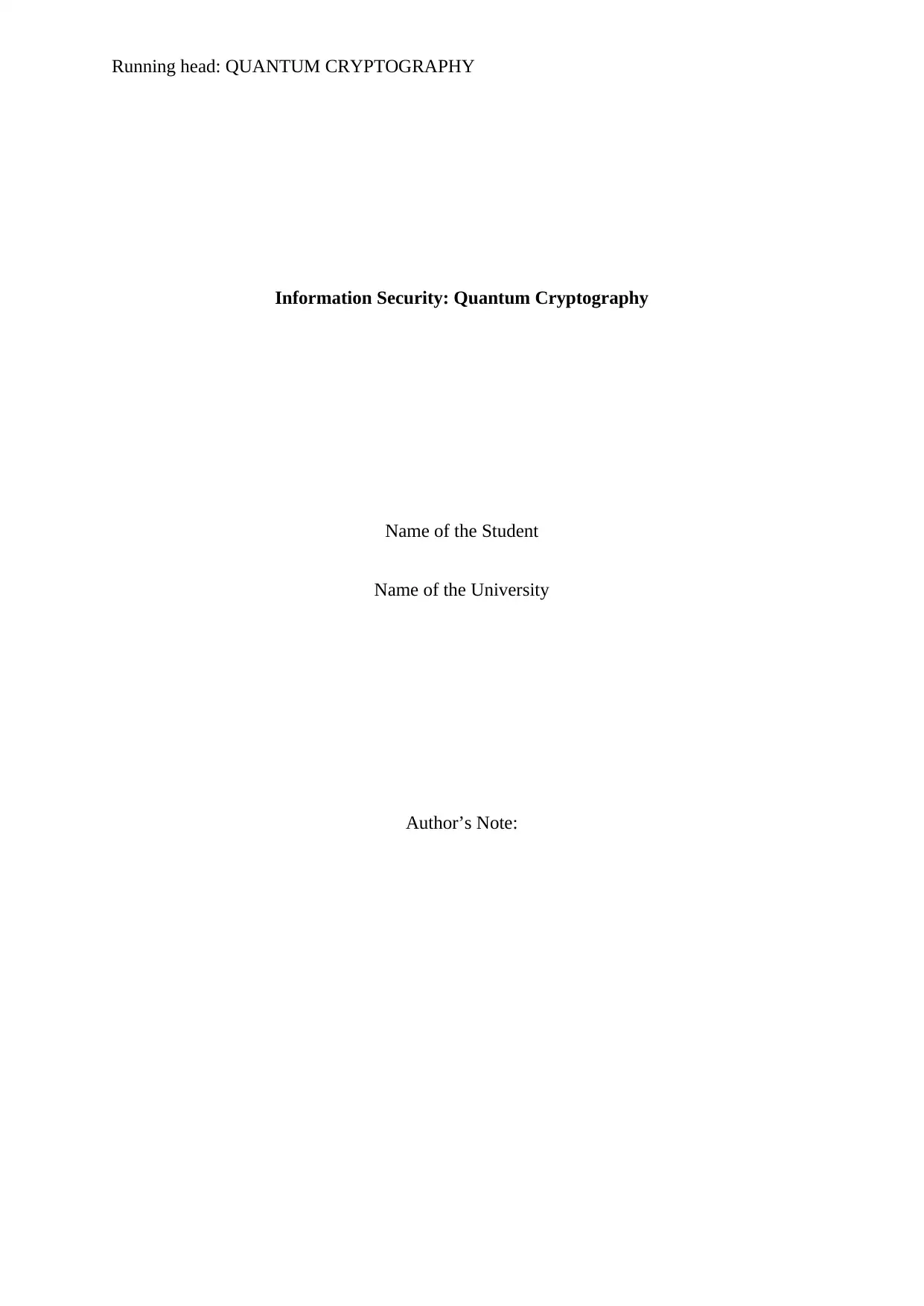
Running head: QUANTUM CRYPTOGRAPHY
Information Security: Quantum Cryptography
Name of the Student
Name of the University
Author’s Note:
Information Security: Quantum Cryptography
Name of the Student
Name of the University
Author’s Note:
Paraphrase This Document
Need a fresh take? Get an instant paraphrase of this document with our AI Paraphraser
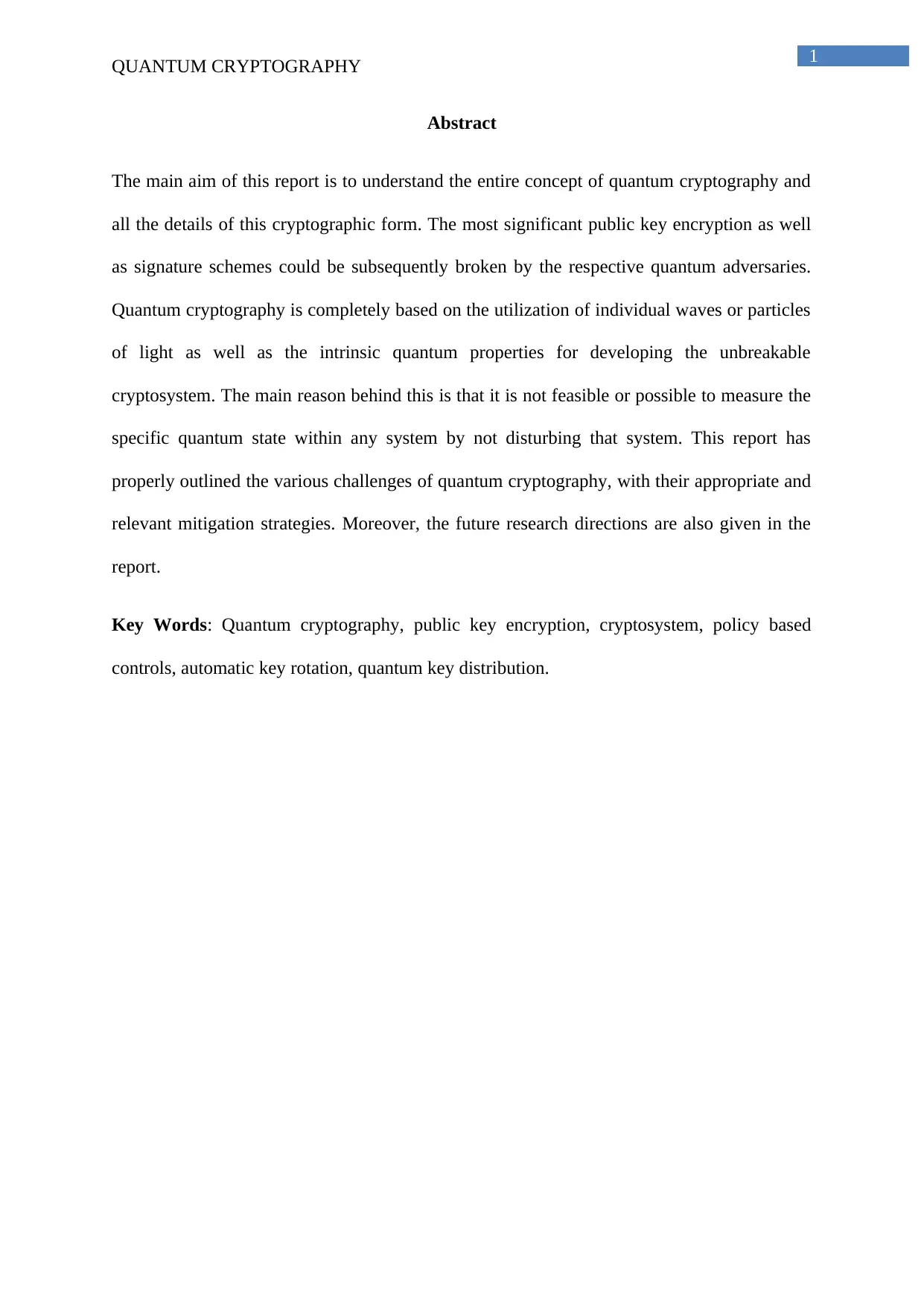
1
QUANTUM CRYPTOGRAPHY
Abstract
The main aim of this report is to understand the entire concept of quantum cryptography and
all the details of this cryptographic form. The most significant public key encryption as well
as signature schemes could be subsequently broken by the respective quantum adversaries.
Quantum cryptography is completely based on the utilization of individual waves or particles
of light as well as the intrinsic quantum properties for developing the unbreakable
cryptosystem. The main reason behind this is that it is not feasible or possible to measure the
specific quantum state within any system by not disturbing that system. This report has
properly outlined the various challenges of quantum cryptography, with their appropriate and
relevant mitigation strategies. Moreover, the future research directions are also given in the
report.
Key Words: Quantum cryptography, public key encryption, cryptosystem, policy based
controls, automatic key rotation, quantum key distribution.
QUANTUM CRYPTOGRAPHY
Abstract
The main aim of this report is to understand the entire concept of quantum cryptography and
all the details of this cryptographic form. The most significant public key encryption as well
as signature schemes could be subsequently broken by the respective quantum adversaries.
Quantum cryptography is completely based on the utilization of individual waves or particles
of light as well as the intrinsic quantum properties for developing the unbreakable
cryptosystem. The main reason behind this is that it is not feasible or possible to measure the
specific quantum state within any system by not disturbing that system. This report has
properly outlined the various challenges of quantum cryptography, with their appropriate and
relevant mitigation strategies. Moreover, the future research directions are also given in the
report.
Key Words: Quantum cryptography, public key encryption, cryptosystem, policy based
controls, automatic key rotation, quantum key distribution.

2
QUANTUM CRYPTOGRAPHY
Table of Contents
Introduction................................................................................................................................3
Discussion..................................................................................................................................3
Definition of Quantum Cryptography....................................................................................3
Benefits of Quantum Cryptography.......................................................................................4
Challenges of Quantum Cryptography...................................................................................5
Mitigation of Challenges in Quantum Cryptography.............................................................6
Future Research Directions....................................................................................................7
Conclusion..................................................................................................................................8
References..................................................................................................................................9
QUANTUM CRYPTOGRAPHY
Table of Contents
Introduction................................................................................................................................3
Discussion..................................................................................................................................3
Definition of Quantum Cryptography....................................................................................3
Benefits of Quantum Cryptography.......................................................................................4
Challenges of Quantum Cryptography...................................................................................5
Mitigation of Challenges in Quantum Cryptography.............................................................6
Future Research Directions....................................................................................................7
Conclusion..................................................................................................................................8
References..................................................................................................................................9
⊘ This is a preview!⊘
Do you want full access?
Subscribe today to unlock all pages.

Trusted by 1+ million students worldwide
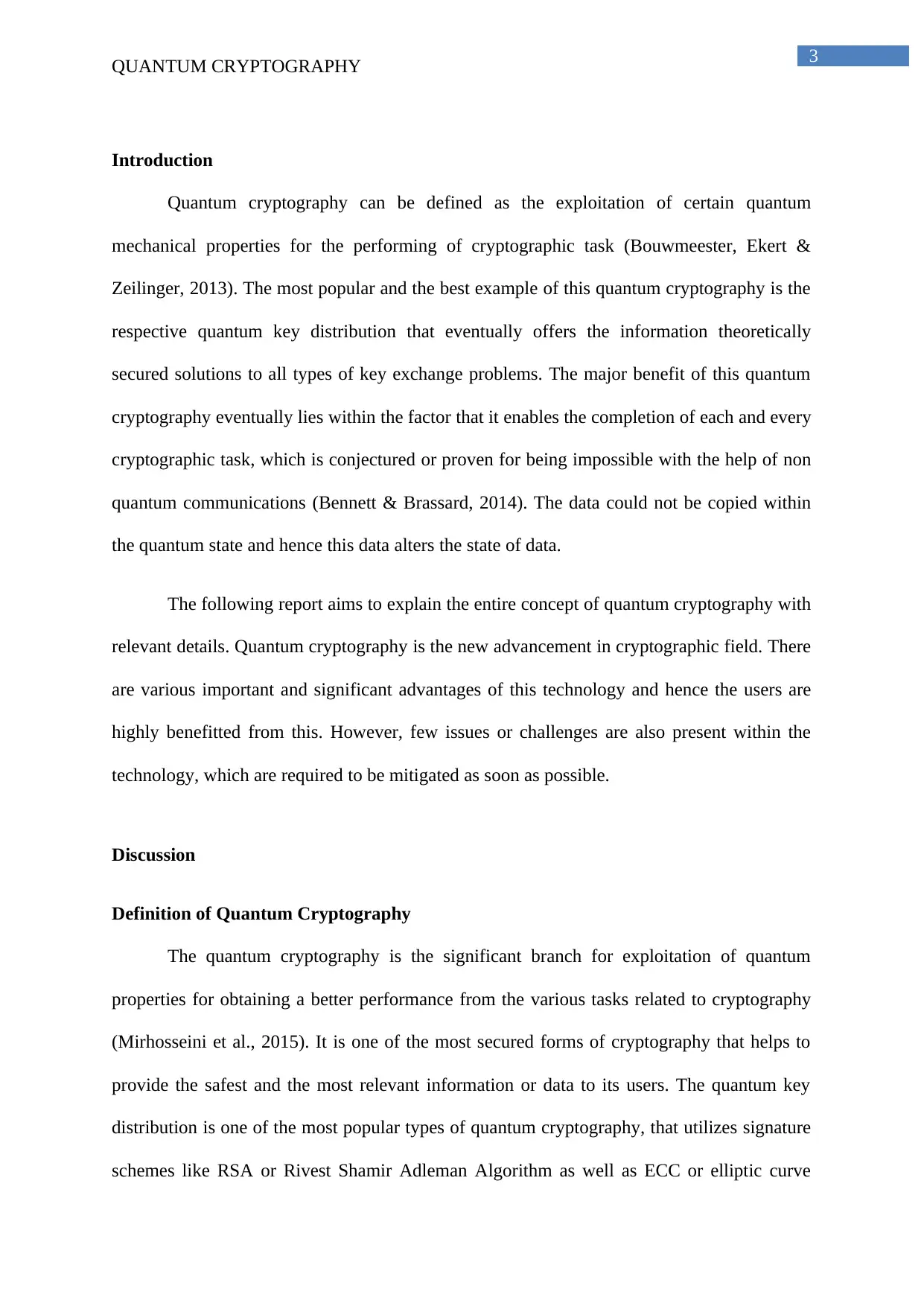
3
QUANTUM CRYPTOGRAPHY
Introduction
Quantum cryptography can be defined as the exploitation of certain quantum
mechanical properties for the performing of cryptographic task (Bouwmeester, Ekert &
Zeilinger, 2013). The most popular and the best example of this quantum cryptography is the
respective quantum key distribution that eventually offers the information theoretically
secured solutions to all types of key exchange problems. The major benefit of this quantum
cryptography eventually lies within the factor that it enables the completion of each and every
cryptographic task, which is conjectured or proven for being impossible with the help of non
quantum communications (Bennett & Brassard, 2014). The data could not be copied within
the quantum state and hence this data alters the state of data.
The following report aims to explain the entire concept of quantum cryptography with
relevant details. Quantum cryptography is the new advancement in cryptographic field. There
are various important and significant advantages of this technology and hence the users are
highly benefitted from this. However, few issues or challenges are also present within the
technology, which are required to be mitigated as soon as possible.
Discussion
Definition of Quantum Cryptography
The quantum cryptography is the significant branch for exploitation of quantum
properties for obtaining a better performance from the various tasks related to cryptography
(Mirhosseini et al., 2015). It is one of the most secured forms of cryptography that helps to
provide the safest and the most relevant information or data to its users. The quantum key
distribution is one of the most popular types of quantum cryptography, that utilizes signature
schemes like RSA or Rivest Shamir Adleman Algorithm as well as ECC or elliptic curve
QUANTUM CRYPTOGRAPHY
Introduction
Quantum cryptography can be defined as the exploitation of certain quantum
mechanical properties for the performing of cryptographic task (Bouwmeester, Ekert &
Zeilinger, 2013). The most popular and the best example of this quantum cryptography is the
respective quantum key distribution that eventually offers the information theoretically
secured solutions to all types of key exchange problems. The major benefit of this quantum
cryptography eventually lies within the factor that it enables the completion of each and every
cryptographic task, which is conjectured or proven for being impossible with the help of non
quantum communications (Bennett & Brassard, 2014). The data could not be copied within
the quantum state and hence this data alters the state of data.
The following report aims to explain the entire concept of quantum cryptography with
relevant details. Quantum cryptography is the new advancement in cryptographic field. There
are various important and significant advantages of this technology and hence the users are
highly benefitted from this. However, few issues or challenges are also present within the
technology, which are required to be mitigated as soon as possible.
Discussion
Definition of Quantum Cryptography
The quantum cryptography is the significant branch for exploitation of quantum
properties for obtaining a better performance from the various tasks related to cryptography
(Mirhosseini et al., 2015). It is one of the most secured forms of cryptography that helps to
provide the safest and the most relevant information or data to its users. The quantum key
distribution is one of the most popular types of quantum cryptography, that utilizes signature
schemes like RSA or Rivest Shamir Adleman Algorithm as well as ECC or elliptic curve
Paraphrase This Document
Need a fresh take? Get an instant paraphrase of this document with our AI Paraphraser
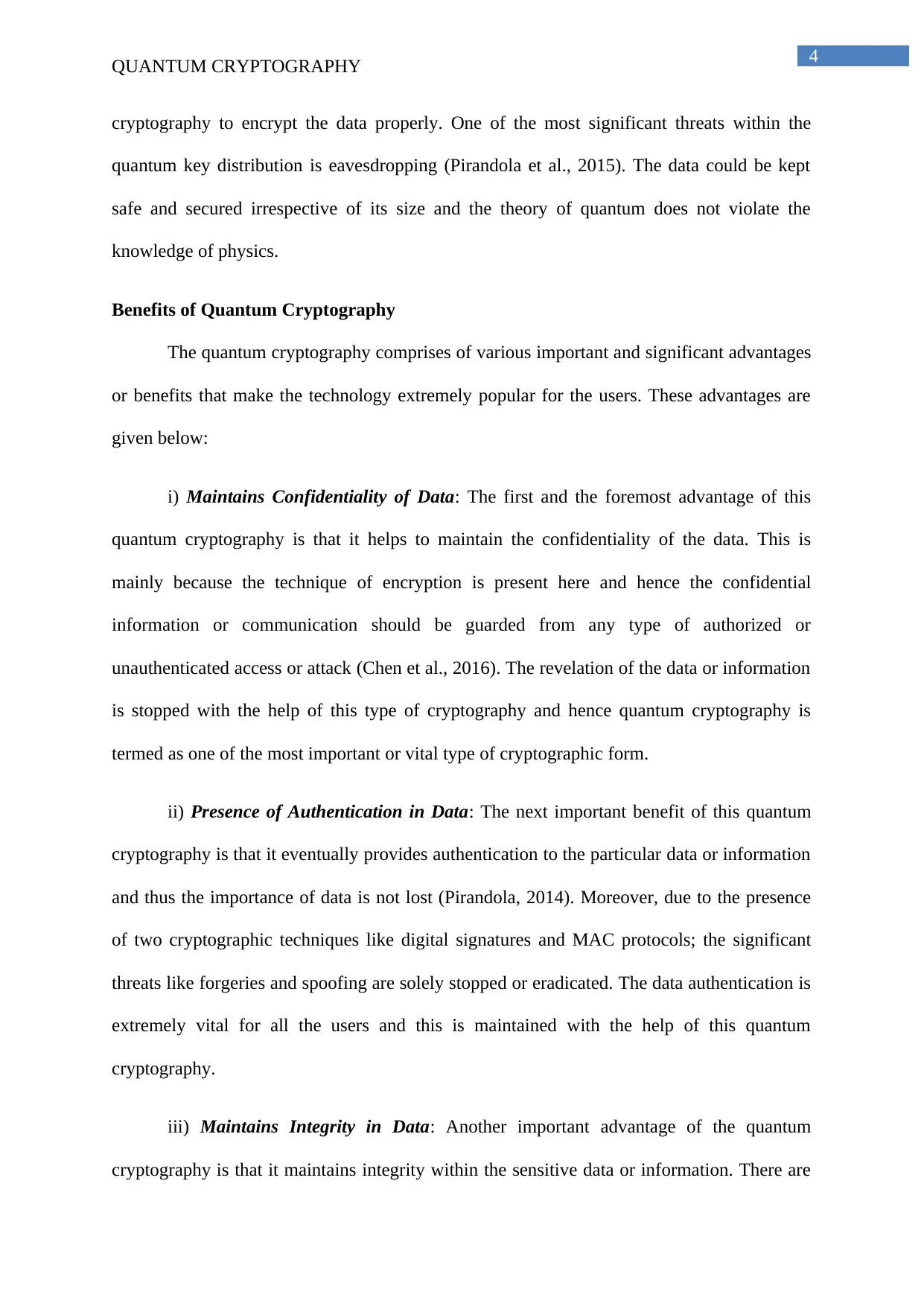
4
QUANTUM CRYPTOGRAPHY
cryptography to encrypt the data properly. One of the most significant threats within the
quantum key distribution is eavesdropping (Pirandola et al., 2015). The data could be kept
safe and secured irrespective of its size and the theory of quantum does not violate the
knowledge of physics.
Benefits of Quantum Cryptography
The quantum cryptography comprises of various important and significant advantages
or benefits that make the technology extremely popular for the users. These advantages are
given below:
i) Maintains Confidentiality of Data: The first and the foremost advantage of this
quantum cryptography is that it helps to maintain the confidentiality of the data. This is
mainly because the technique of encryption is present here and hence the confidential
information or communication should be guarded from any type of authorized or
unauthenticated access or attack (Chen et al., 2016). The revelation of the data or information
is stopped with the help of this type of cryptography and hence quantum cryptography is
termed as one of the most important or vital type of cryptographic form.
ii) Presence of Authentication in Data: The next important benefit of this quantum
cryptography is that it eventually provides authentication to the particular data or information
and thus the importance of data is not lost (Pirandola, 2014). Moreover, due to the presence
of two cryptographic techniques like digital signatures and MAC protocols; the significant
threats like forgeries and spoofing are solely stopped or eradicated. The data authentication is
extremely vital for all the users and this is maintained with the help of this quantum
cryptography.
iii) Maintains Integrity in Data: Another important advantage of the quantum
cryptography is that it maintains integrity within the sensitive data or information. There are
QUANTUM CRYPTOGRAPHY
cryptography to encrypt the data properly. One of the most significant threats within the
quantum key distribution is eavesdropping (Pirandola et al., 2015). The data could be kept
safe and secured irrespective of its size and the theory of quantum does not violate the
knowledge of physics.
Benefits of Quantum Cryptography
The quantum cryptography comprises of various important and significant advantages
or benefits that make the technology extremely popular for the users. These advantages are
given below:
i) Maintains Confidentiality of Data: The first and the foremost advantage of this
quantum cryptography is that it helps to maintain the confidentiality of the data. This is
mainly because the technique of encryption is present here and hence the confidential
information or communication should be guarded from any type of authorized or
unauthenticated access or attack (Chen et al., 2016). The revelation of the data or information
is stopped with the help of this type of cryptography and hence quantum cryptography is
termed as one of the most important or vital type of cryptographic form.
ii) Presence of Authentication in Data: The next important benefit of this quantum
cryptography is that it eventually provides authentication to the particular data or information
and thus the importance of data is not lost (Pirandola, 2014). Moreover, due to the presence
of two cryptographic techniques like digital signatures and MAC protocols; the significant
threats like forgeries and spoofing are solely stopped or eradicated. The data authentication is
extremely vital for all the users and this is maintained with the help of this quantum
cryptography.
iii) Maintains Integrity in Data: Another important advantage of the quantum
cryptography is that it maintains integrity within the sensitive data or information. There are
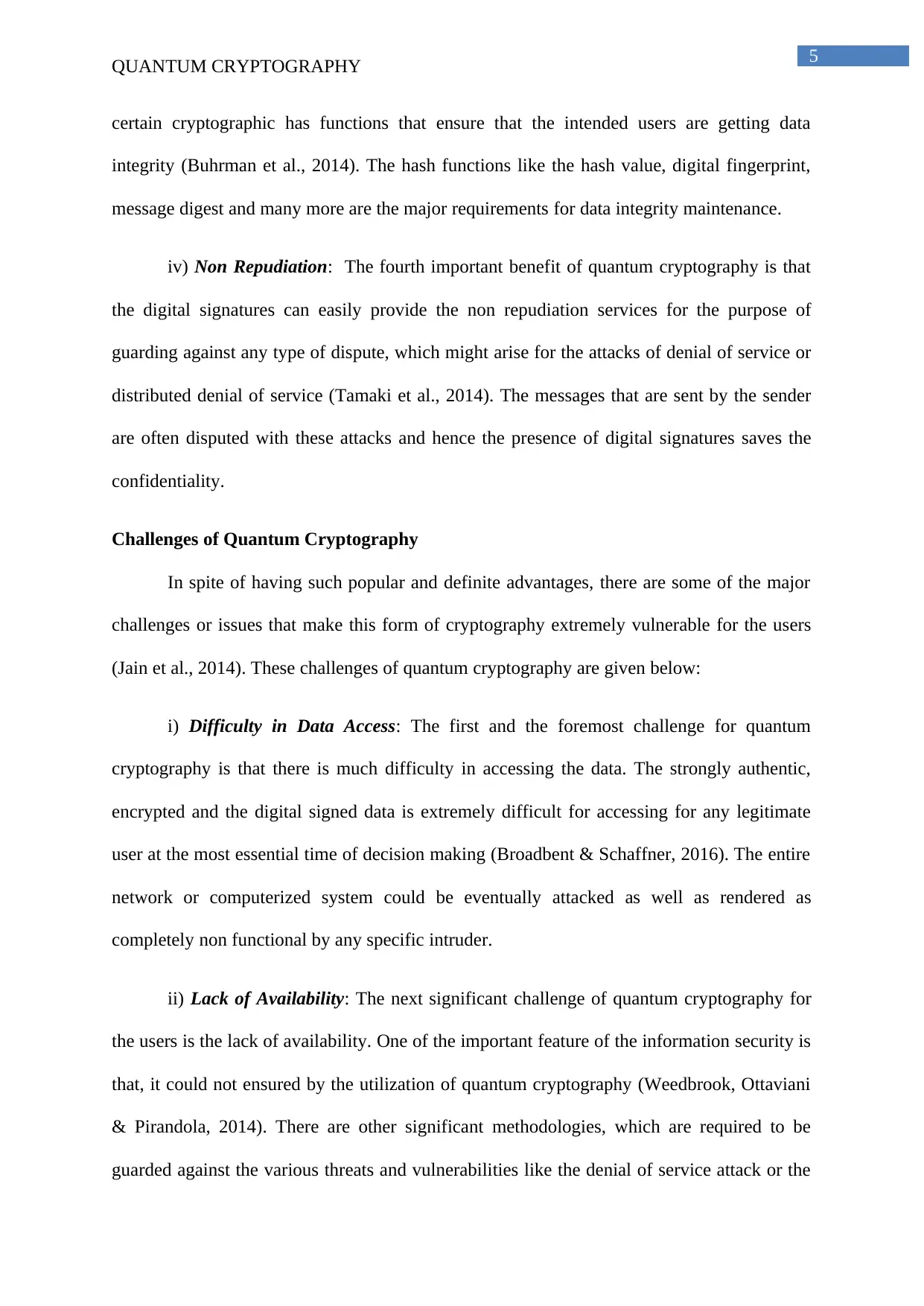
5
QUANTUM CRYPTOGRAPHY
certain cryptographic has functions that ensure that the intended users are getting data
integrity (Buhrman et al., 2014). The hash functions like the hash value, digital fingerprint,
message digest and many more are the major requirements for data integrity maintenance.
iv) Non Repudiation: The fourth important benefit of quantum cryptography is that
the digital signatures can easily provide the non repudiation services for the purpose of
guarding against any type of dispute, which might arise for the attacks of denial of service or
distributed denial of service (Tamaki et al., 2014). The messages that are sent by the sender
are often disputed with these attacks and hence the presence of digital signatures saves the
confidentiality.
Challenges of Quantum Cryptography
In spite of having such popular and definite advantages, there are some of the major
challenges or issues that make this form of cryptography extremely vulnerable for the users
(Jain et al., 2014). These challenges of quantum cryptography are given below:
i) Difficulty in Data Access: The first and the foremost challenge for quantum
cryptography is that there is much difficulty in accessing the data. The strongly authentic,
encrypted and the digital signed data is extremely difficult for accessing for any legitimate
user at the most essential time of decision making (Broadbent & Schaffner, 2016). The entire
network or computerized system could be eventually attacked as well as rendered as
completely non functional by any specific intruder.
ii) Lack of Availability: The next significant challenge of quantum cryptography for
the users is the lack of availability. One of the important feature of the information security is
that, it could not ensured by the utilization of quantum cryptography (Weedbrook, Ottaviani
& Pirandola, 2014). There are other significant methodologies, which are required to be
guarded against the various threats and vulnerabilities like the denial of service attack or the
QUANTUM CRYPTOGRAPHY
certain cryptographic has functions that ensure that the intended users are getting data
integrity (Buhrman et al., 2014). The hash functions like the hash value, digital fingerprint,
message digest and many more are the major requirements for data integrity maintenance.
iv) Non Repudiation: The fourth important benefit of quantum cryptography is that
the digital signatures can easily provide the non repudiation services for the purpose of
guarding against any type of dispute, which might arise for the attacks of denial of service or
distributed denial of service (Tamaki et al., 2014). The messages that are sent by the sender
are often disputed with these attacks and hence the presence of digital signatures saves the
confidentiality.
Challenges of Quantum Cryptography
In spite of having such popular and definite advantages, there are some of the major
challenges or issues that make this form of cryptography extremely vulnerable for the users
(Jain et al., 2014). These challenges of quantum cryptography are given below:
i) Difficulty in Data Access: The first and the foremost challenge for quantum
cryptography is that there is much difficulty in accessing the data. The strongly authentic,
encrypted and the digital signed data is extremely difficult for accessing for any legitimate
user at the most essential time of decision making (Broadbent & Schaffner, 2016). The entire
network or computerized system could be eventually attacked as well as rendered as
completely non functional by any specific intruder.
ii) Lack of Availability: The next significant challenge of quantum cryptography for
the users is the lack of availability. One of the important feature of the information security is
that, it could not ensured by the utilization of quantum cryptography (Weedbrook, Ottaviani
& Pirandola, 2014). There are other significant methodologies, which are required to be
guarded against the various threats and vulnerabilities like the denial of service attack or the
⊘ This is a preview!⊘
Do you want full access?
Subscribe today to unlock all pages.

Trusted by 1+ million students worldwide
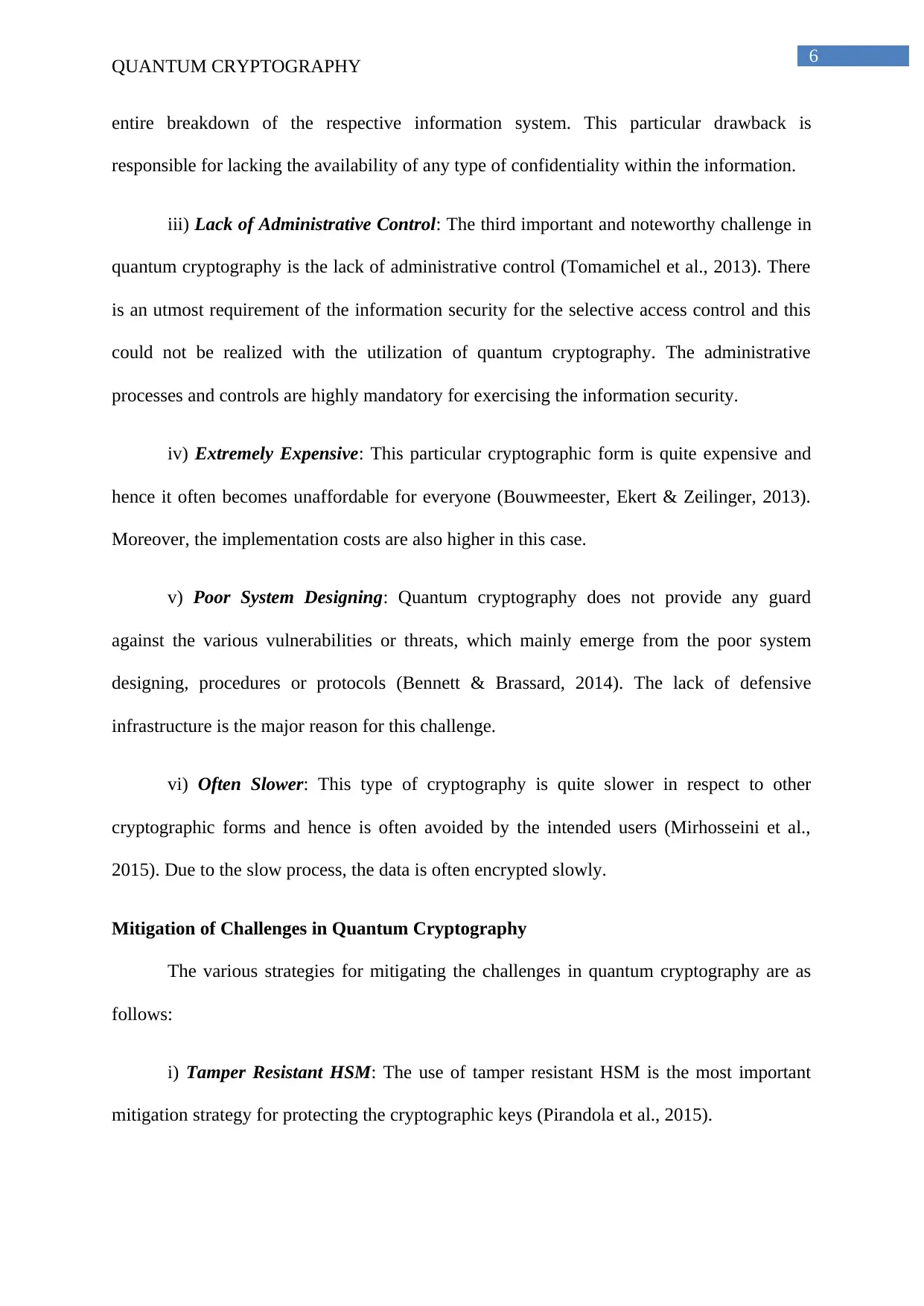
6
QUANTUM CRYPTOGRAPHY
entire breakdown of the respective information system. This particular drawback is
responsible for lacking the availability of any type of confidentiality within the information.
iii) Lack of Administrative Control: The third important and noteworthy challenge in
quantum cryptography is the lack of administrative control (Tomamichel et al., 2013). There
is an utmost requirement of the information security for the selective access control and this
could not be realized with the utilization of quantum cryptography. The administrative
processes and controls are highly mandatory for exercising the information security.
iv) Extremely Expensive: This particular cryptographic form is quite expensive and
hence it often becomes unaffordable for everyone (Bouwmeester, Ekert & Zeilinger, 2013).
Moreover, the implementation costs are also higher in this case.
v) Poor System Designing: Quantum cryptography does not provide any guard
against the various vulnerabilities or threats, which mainly emerge from the poor system
designing, procedures or protocols (Bennett & Brassard, 2014). The lack of defensive
infrastructure is the major reason for this challenge.
vi) Often Slower: This type of cryptography is quite slower in respect to other
cryptographic forms and hence is often avoided by the intended users (Mirhosseini et al.,
2015). Due to the slow process, the data is often encrypted slowly.
Mitigation of Challenges in Quantum Cryptography
The various strategies for mitigating the challenges in quantum cryptography are as
follows:
i) Tamper Resistant HSM: The use of tamper resistant HSM is the most important
mitigation strategy for protecting the cryptographic keys (Pirandola et al., 2015).
QUANTUM CRYPTOGRAPHY
entire breakdown of the respective information system. This particular drawback is
responsible for lacking the availability of any type of confidentiality within the information.
iii) Lack of Administrative Control: The third important and noteworthy challenge in
quantum cryptography is the lack of administrative control (Tomamichel et al., 2013). There
is an utmost requirement of the information security for the selective access control and this
could not be realized with the utilization of quantum cryptography. The administrative
processes and controls are highly mandatory for exercising the information security.
iv) Extremely Expensive: This particular cryptographic form is quite expensive and
hence it often becomes unaffordable for everyone (Bouwmeester, Ekert & Zeilinger, 2013).
Moreover, the implementation costs are also higher in this case.
v) Poor System Designing: Quantum cryptography does not provide any guard
against the various vulnerabilities or threats, which mainly emerge from the poor system
designing, procedures or protocols (Bennett & Brassard, 2014). The lack of defensive
infrastructure is the major reason for this challenge.
vi) Often Slower: This type of cryptography is quite slower in respect to other
cryptographic forms and hence is often avoided by the intended users (Mirhosseini et al.,
2015). Due to the slow process, the data is often encrypted slowly.
Mitigation of Challenges in Quantum Cryptography
The various strategies for mitigating the challenges in quantum cryptography are as
follows:
i) Tamper Resistant HSM: The use of tamper resistant HSM is the most important
mitigation strategy for protecting the cryptographic keys (Pirandola et al., 2015).
Paraphrase This Document
Need a fresh take? Get an instant paraphrase of this document with our AI Paraphraser

7
QUANTUM CRYPTOGRAPHY
ii) FIPS Certified RNG: The significant generation of the stronger keys with the help
of FIPS certified RNG as well as hardware entropy sources are the next popular mitigation
strategy.
iii) Policy Based Controls: The policy based controls are another important strategy
to mitigate the issues related to quantum cryptography (Chen et al., 2016). These policy
based controls are extremely strict and are used for the proper prevention of misuse or reuse
of the respective cryptographic keys.
iv) Import and Export of Keys: The periodical import and export of the cryptographic
keys is the next important strategy for securing the keys under a specific transport key.
v) User Authentication: The strong user authentication or the dual control on crucial
operations is the next mitigation strategies for securing data or keys in quantum cryptography
(Pirandola, 2014).
vi) Intuitive User Interfaces: The user interface as well as the secured workflow
management for the purpose of minimizing the significant risk of the human errors.
vii) Automated Key Rotation: The automated key rotation is the next mitigation
strategy for mitigating the challenges in quantum cryptography (Buhrman et al., 2014).
Future Research Directions
The significant security of quantum key distribution or QKD protocol can be a future
research direction. Moreover, the unconditional security or privacy of this quantum
cryptography for reducing the increasing challenges is also inevitable in future (Weedbrook,
Ottaviani & Pirandola, 2014). The next future direction is the detection of sniffing and hence
reducing the existing threats and vulnerabilities.
QUANTUM CRYPTOGRAPHY
ii) FIPS Certified RNG: The significant generation of the stronger keys with the help
of FIPS certified RNG as well as hardware entropy sources are the next popular mitigation
strategy.
iii) Policy Based Controls: The policy based controls are another important strategy
to mitigate the issues related to quantum cryptography (Chen et al., 2016). These policy
based controls are extremely strict and are used for the proper prevention of misuse or reuse
of the respective cryptographic keys.
iv) Import and Export of Keys: The periodical import and export of the cryptographic
keys is the next important strategy for securing the keys under a specific transport key.
v) User Authentication: The strong user authentication or the dual control on crucial
operations is the next mitigation strategies for securing data or keys in quantum cryptography
(Pirandola, 2014).
vi) Intuitive User Interfaces: The user interface as well as the secured workflow
management for the purpose of minimizing the significant risk of the human errors.
vii) Automated Key Rotation: The automated key rotation is the next mitigation
strategy for mitigating the challenges in quantum cryptography (Buhrman et al., 2014).
Future Research Directions
The significant security of quantum key distribution or QKD protocol can be a future
research direction. Moreover, the unconditional security or privacy of this quantum
cryptography for reducing the increasing challenges is also inevitable in future (Weedbrook,
Ottaviani & Pirandola, 2014). The next future direction is the detection of sniffing and hence
reducing the existing threats and vulnerabilities.
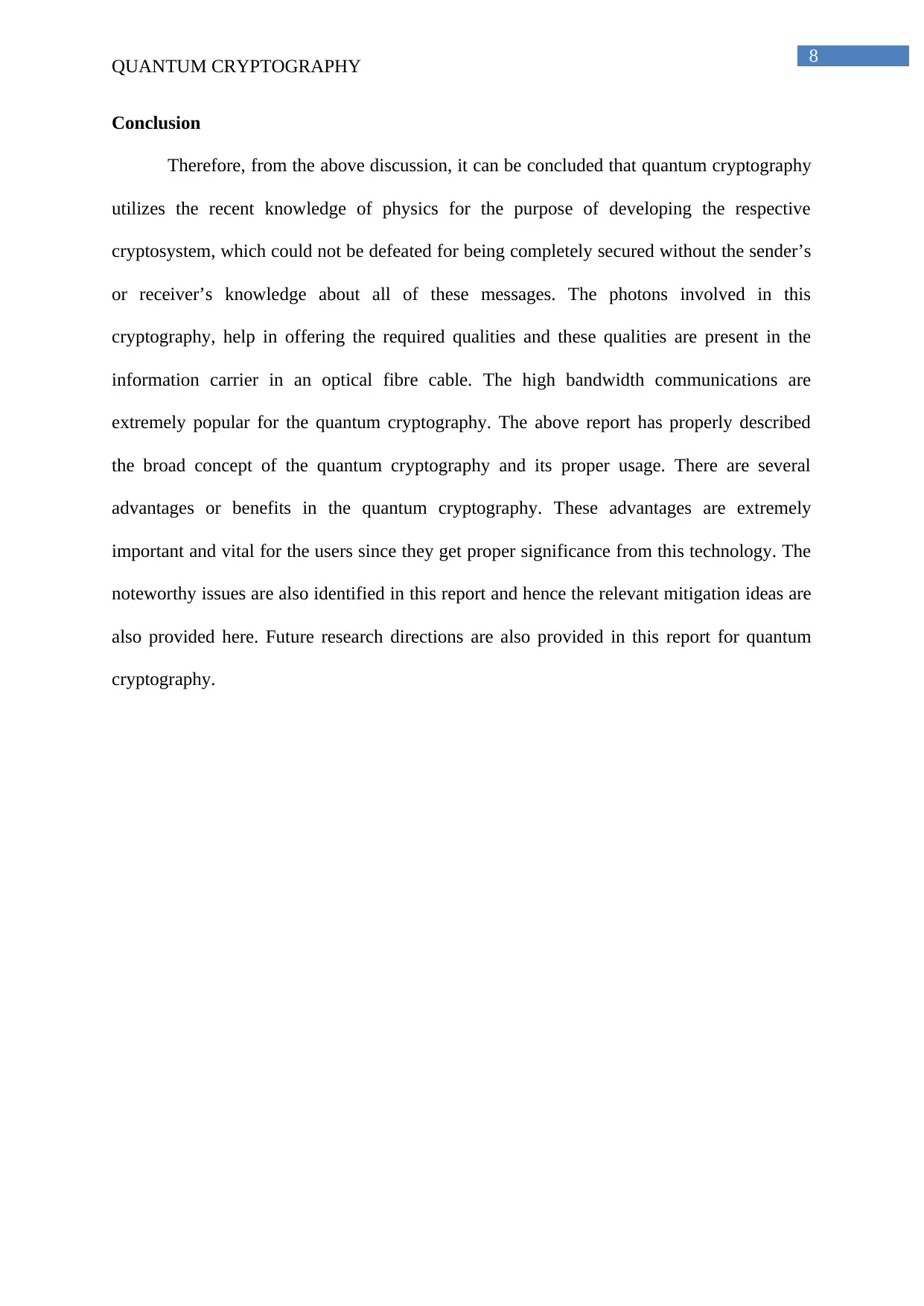
8
QUANTUM CRYPTOGRAPHY
Conclusion
Therefore, from the above discussion, it can be concluded that quantum cryptography
utilizes the recent knowledge of physics for the purpose of developing the respective
cryptosystem, which could not be defeated for being completely secured without the sender’s
or receiver’s knowledge about all of these messages. The photons involved in this
cryptography, help in offering the required qualities and these qualities are present in the
information carrier in an optical fibre cable. The high bandwidth communications are
extremely popular for the quantum cryptography. The above report has properly described
the broad concept of the quantum cryptography and its proper usage. There are several
advantages or benefits in the quantum cryptography. These advantages are extremely
important and vital for the users since they get proper significance from this technology. The
noteworthy issues are also identified in this report and hence the relevant mitigation ideas are
also provided here. Future research directions are also provided in this report for quantum
cryptography.
QUANTUM CRYPTOGRAPHY
Conclusion
Therefore, from the above discussion, it can be concluded that quantum cryptography
utilizes the recent knowledge of physics for the purpose of developing the respective
cryptosystem, which could not be defeated for being completely secured without the sender’s
or receiver’s knowledge about all of these messages. The photons involved in this
cryptography, help in offering the required qualities and these qualities are present in the
information carrier in an optical fibre cable. The high bandwidth communications are
extremely popular for the quantum cryptography. The above report has properly described
the broad concept of the quantum cryptography and its proper usage. There are several
advantages or benefits in the quantum cryptography. These advantages are extremely
important and vital for the users since they get proper significance from this technology. The
noteworthy issues are also identified in this report and hence the relevant mitigation ideas are
also provided here. Future research directions are also provided in this report for quantum
cryptography.
⊘ This is a preview!⊘
Do you want full access?
Subscribe today to unlock all pages.

Trusted by 1+ million students worldwide
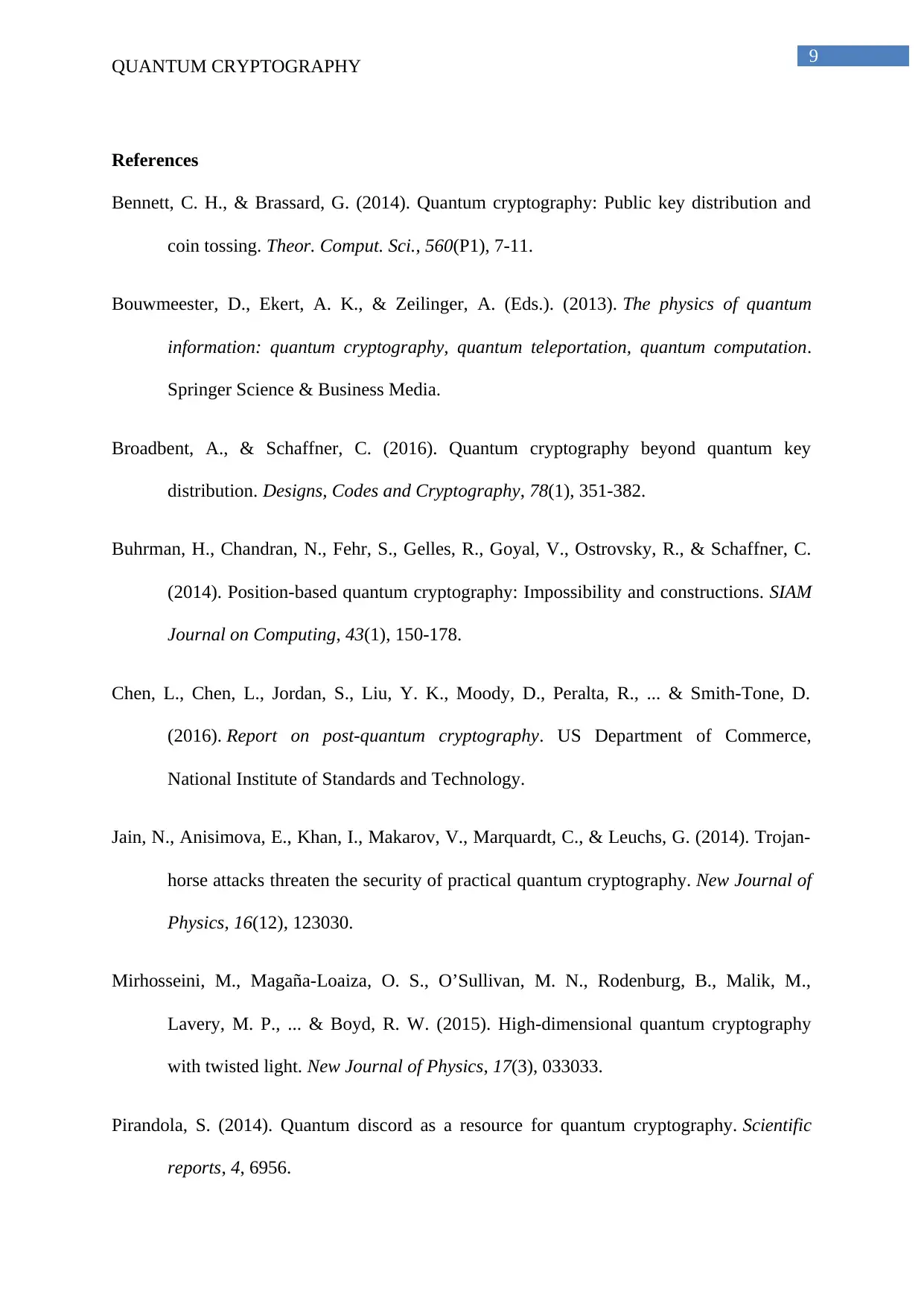
9
QUANTUM CRYPTOGRAPHY
References
Bennett, C. H., & Brassard, G. (2014). Quantum cryptography: Public key distribution and
coin tossing. Theor. Comput. Sci., 560(P1), 7-11.
Bouwmeester, D., Ekert, A. K., & Zeilinger, A. (Eds.). (2013). The physics of quantum
information: quantum cryptography, quantum teleportation, quantum computation.
Springer Science & Business Media.
Broadbent, A., & Schaffner, C. (2016). Quantum cryptography beyond quantum key
distribution. Designs, Codes and Cryptography, 78(1), 351-382.
Buhrman, H., Chandran, N., Fehr, S., Gelles, R., Goyal, V., Ostrovsky, R., & Schaffner, C.
(2014). Position-based quantum cryptography: Impossibility and constructions. SIAM
Journal on Computing, 43(1), 150-178.
Chen, L., Chen, L., Jordan, S., Liu, Y. K., Moody, D., Peralta, R., ... & Smith-Tone, D.
(2016). Report on post-quantum cryptography. US Department of Commerce,
National Institute of Standards and Technology.
Jain, N., Anisimova, E., Khan, I., Makarov, V., Marquardt, C., & Leuchs, G. (2014). Trojan-
horse attacks threaten the security of practical quantum cryptography. New Journal of
Physics, 16(12), 123030.
Mirhosseini, M., Magaña-Loaiza, O. S., O’Sullivan, M. N., Rodenburg, B., Malik, M.,
Lavery, M. P., ... & Boyd, R. W. (2015). High-dimensional quantum cryptography
with twisted light. New Journal of Physics, 17(3), 033033.
Pirandola, S. (2014). Quantum discord as a resource for quantum cryptography. Scientific
reports, 4, 6956.
QUANTUM CRYPTOGRAPHY
References
Bennett, C. H., & Brassard, G. (2014). Quantum cryptography: Public key distribution and
coin tossing. Theor. Comput. Sci., 560(P1), 7-11.
Bouwmeester, D., Ekert, A. K., & Zeilinger, A. (Eds.). (2013). The physics of quantum
information: quantum cryptography, quantum teleportation, quantum computation.
Springer Science & Business Media.
Broadbent, A., & Schaffner, C. (2016). Quantum cryptography beyond quantum key
distribution. Designs, Codes and Cryptography, 78(1), 351-382.
Buhrman, H., Chandran, N., Fehr, S., Gelles, R., Goyal, V., Ostrovsky, R., & Schaffner, C.
(2014). Position-based quantum cryptography: Impossibility and constructions. SIAM
Journal on Computing, 43(1), 150-178.
Chen, L., Chen, L., Jordan, S., Liu, Y. K., Moody, D., Peralta, R., ... & Smith-Tone, D.
(2016). Report on post-quantum cryptography. US Department of Commerce,
National Institute of Standards and Technology.
Jain, N., Anisimova, E., Khan, I., Makarov, V., Marquardt, C., & Leuchs, G. (2014). Trojan-
horse attacks threaten the security of practical quantum cryptography. New Journal of
Physics, 16(12), 123030.
Mirhosseini, M., Magaña-Loaiza, O. S., O’Sullivan, M. N., Rodenburg, B., Malik, M.,
Lavery, M. P., ... & Boyd, R. W. (2015). High-dimensional quantum cryptography
with twisted light. New Journal of Physics, 17(3), 033033.
Pirandola, S. (2014). Quantum discord as a resource for quantum cryptography. Scientific
reports, 4, 6956.
Paraphrase This Document
Need a fresh take? Get an instant paraphrase of this document with our AI Paraphraser
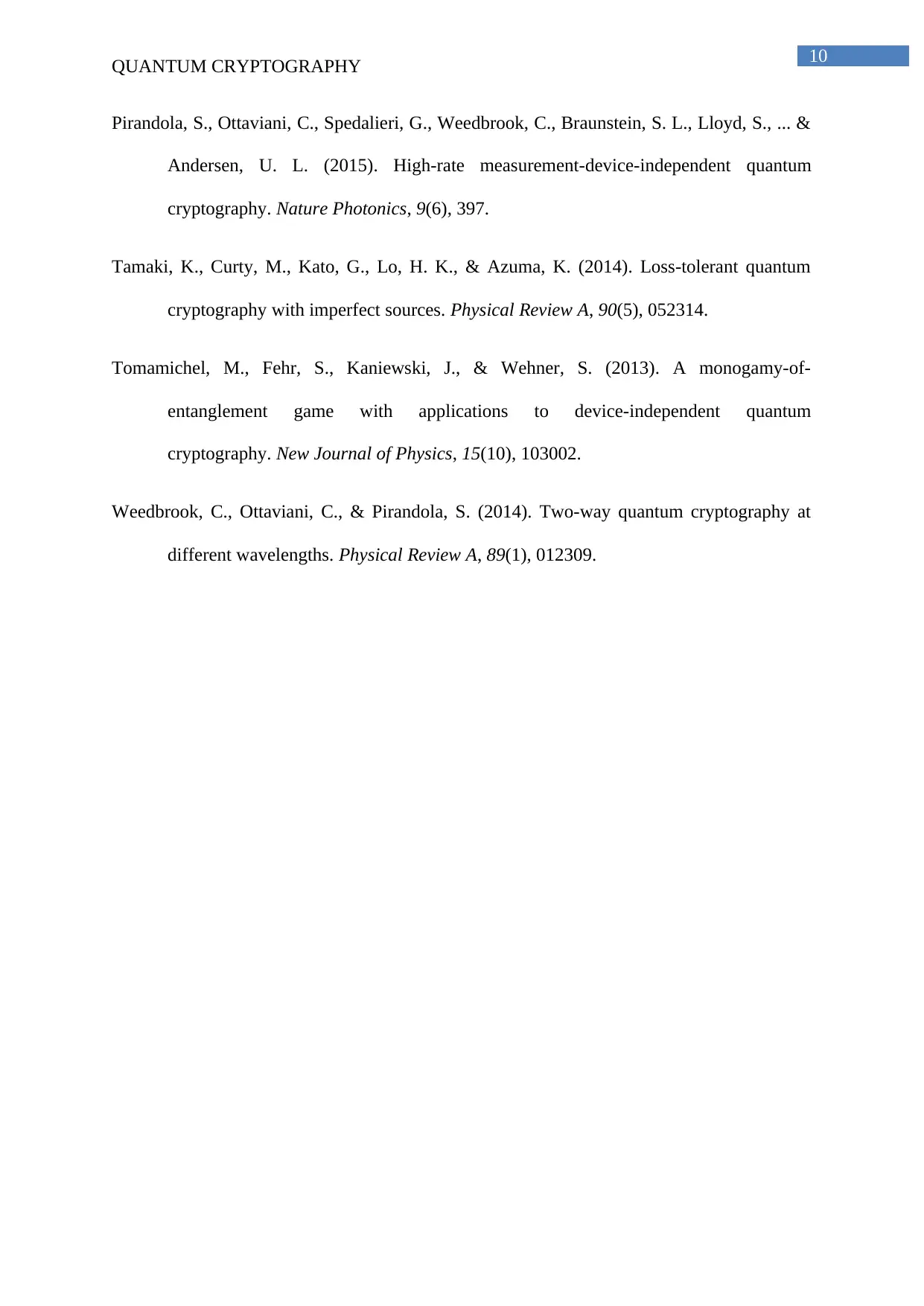
10
QUANTUM CRYPTOGRAPHY
Pirandola, S., Ottaviani, C., Spedalieri, G., Weedbrook, C., Braunstein, S. L., Lloyd, S., ... &
Andersen, U. L. (2015). High-rate measurement-device-independent quantum
cryptography. Nature Photonics, 9(6), 397.
Tamaki, K., Curty, M., Kato, G., Lo, H. K., & Azuma, K. (2014). Loss-tolerant quantum
cryptography with imperfect sources. Physical Review A, 90(5), 052314.
Tomamichel, M., Fehr, S., Kaniewski, J., & Wehner, S. (2013). A monogamy-of-
entanglement game with applications to device-independent quantum
cryptography. New Journal of Physics, 15(10), 103002.
Weedbrook, C., Ottaviani, C., & Pirandola, S. (2014). Two-way quantum cryptography at
different wavelengths. Physical Review A, 89(1), 012309.
QUANTUM CRYPTOGRAPHY
Pirandola, S., Ottaviani, C., Spedalieri, G., Weedbrook, C., Braunstein, S. L., Lloyd, S., ... &
Andersen, U. L. (2015). High-rate measurement-device-independent quantum
cryptography. Nature Photonics, 9(6), 397.
Tamaki, K., Curty, M., Kato, G., Lo, H. K., & Azuma, K. (2014). Loss-tolerant quantum
cryptography with imperfect sources. Physical Review A, 90(5), 052314.
Tomamichel, M., Fehr, S., Kaniewski, J., & Wehner, S. (2013). A monogamy-of-
entanglement game with applications to device-independent quantum
cryptography. New Journal of Physics, 15(10), 103002.
Weedbrook, C., Ottaviani, C., & Pirandola, S. (2014). Two-way quantum cryptography at
different wavelengths. Physical Review A, 89(1), 012309.
1 out of 11